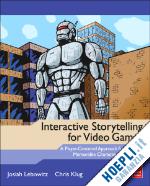Chapter 1: Game Stories, Interactivity, and What Players Want The Importance of Stories Stories in Video Games Interactive Stories vs. Traditional Stories: The Great Debate Summary Things to Consider Chapter 2: A Brief History of Storytelling in Games The Early Days The Beginnings of Game Stories Text Adventures and Interactive Fiction RPGs, Adventure Games, and the Growing Importance of Stories The Cinematic Evolution of Game Stories Game Stories Today The Limits of Storytelling in Games Summary Things to Consider Chapter 3: The Hero's Journey and the Structure of Game Stories Types of Stories Best Suited for Games The "Best" Story Types Using Non-Ideal Stories The Hero's Journey What is the hero's journey? Structure of the Hero's Journey Stage 1: The Ordinary World Stage 2: The Call to Adventure Stage 3: Refusing the Call Stage 4: The Mentor Stage 5: The First Threshold Stage 6: The Journey Stage 7: The "Final Dungeon" Stage 8: The Great Ordeal Stage 9: The Prize Stage 10: The Road Home Stage 11: The Return Modifying the Structure Stage 1: The Ordinary World Stage 2: The Call to Adventures Stage 3: Refusing the Call Stage 4: The Mentor Stage 5: The First Threshold Stage 6: The Journey Stage 7: The "Final Dungeon" Stage 8: The Great Ordeal Stage 9: The Prize Stage 10: The Road Home Stage 11: The Return Common Themes and Clichés in Game Storytelling Common Clichés and Themes The Amnesiac Hero The Evil Vizier/Minister/Aide/Etc No One Noticing the Evil Vizier/Minister/Aide/Etc The Last of His Race I am Your Father A Party of Clichés Saving the World from Evil The Ancient Civilization Why Clichés are Used When to Use and When to Avoid Story Clichés Rule 1 Rule 2 Rule 3 Rule 4 Summary Things to Consider Chapter 4: The Story and the Characters Story Flow and Progression The Importance of Proper Flow and Pacing Don't Neglect the Little Things Keeping the Player Engaged Character Development Common Character Archetypes The Young Hero The Reluctant Hero The Best Friend The Special Person The Mentor The Veteran The Gambler The Seductress The Hardened Criminal The Cold Calculating Villain Advantages of Using Archetypes Disadvantages of Using Archetypes Making Characters Believable Character Actions and Decisions Character Dialogue How Much to Tell and Not Tell Players The Importance of Backstory How to Tell the Backstory Earth and Beyond, the MMO Deciding What to Tell Sometimes a Mystery is Best Summary Things to Consider Chapter 5: Making Stories Emotional Connecting With the Characters The Fine Line Between Drama and Melodrama Making the Player Cry Summary Things to Consider Chapter 6: Defining Interactive and Player-Driven Storytelling What makes a story interactive? What makes a story player-driven? Interactive Storytelling as a Spectrum Fully Traditional Stories Interactive Traditional Stories Multiple-Ending Stories Branching Path Stories Open-Ended Stories Fully Player-Driven Stories How Stories are Classified Games without Stories Summary Things to Consider Chapter 7: Fully Traditional and Interactive Traditional Stories Fully Traditional Stories Fully traditional stories, Video Games, and Why They Don't Mix Interactive Traditional Stories Creating Interactive Traditional Stories Player's Characters Speaking Dialogue The Strengths of Interactive Traditional Stories The Weaknesses of Interactive Traditional Stories Summary Things to Consider Chapter 8: Multiple-Ending Stories Creating Multiple-Ending Stories What types of endings should a game have? Choosing Where to End the Game How many endings does a game need? Determining Which Ending the Player Sees Multiple-Ending Stories and Sequels The Strengths of Multiple-Ending Stories The Weaknesses of Multiple-Ending Stories Summary Things to Consider Chapter 9: Branching Path Stories Creating Branching Path Stories Types of Branches Minor Branches Moderate Branches Major Branches Deciding Where to Place Branches How many branches should a story have? Japanese Visual Novel Games The Strengths of Branching Path Stories The Weaknesses of Branching Path Stories Summary Things to Consider Chapter 10: Open-Ended Stories Creating Open-Ended Stories The Main Plot The Branches The "Distractions" The Strengths of Open-Ended Stories The Weaknesses of Open-Ended Stories Summary Things to Consider Chapter 11: Fully Player-Driven Stories Creating Fully Player-Driven Stories Creating a Setting Creating Rules of Interaction The Problem with Fully Player-Driven Stories in Video Games MMOs The Strengths of Fully Player-Driven Stories The Weaknesses of Fully Player-Driven Stories Summary Things to Consider Chapter 12: The Argument for the Supremacy of Player-Driven Storytelling The Evolution of the Art Form Giving the Writer Greater Freedom Strengthening the Player - Character Bond Giving the Player What He Wants Summary Things to Consider Chapter 13: The Argument Against the Supremacy of Player-Driven Storytelling The Fine Art of Storytelling Time, Money, and Player Interest The Added Time and Expense of Creating Player-Driven Stories Adding Interaction at the Expense of Other Elements Who is going to see it all? Keeping the Story Interesting Story Structure and the "Ideal" Chain of Events The Problem with How We Think Trying to Correct a Mistake Loss of Impact The Illusion of Control Giving the Player What He Wants Summary Things to Consider Chapter 14: What Players Really Want: The Most Important Issue Do players know what they really want? The Survey How important are game stories to players? What Players Say They Want Story Preferences by the Numbers What Players Really Want The Best Game Stories Further Analysis Do stories sell games? Buying Habits by the Numbers Further Analysis Summary Things to Consider Chapter 15: The Future of Storytelling in Games Stories Then and Now The Key Arguments What Players Want Looking Towards the Future The Most Popular Types of Storytelling A Future for Everyone Things to Consider Glossary Appendix A: Game Writing Groups and Other Useful Resources Appendix B: Survey Data Bibliography and References











